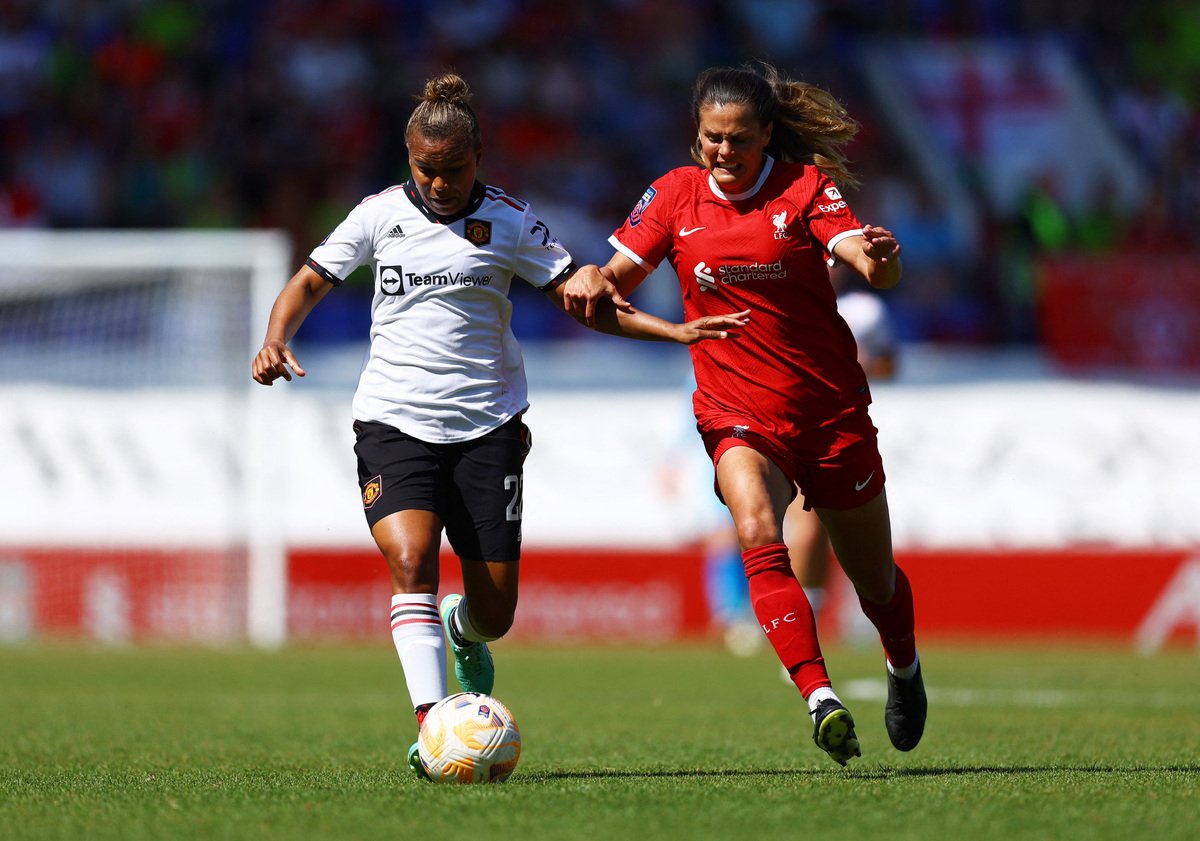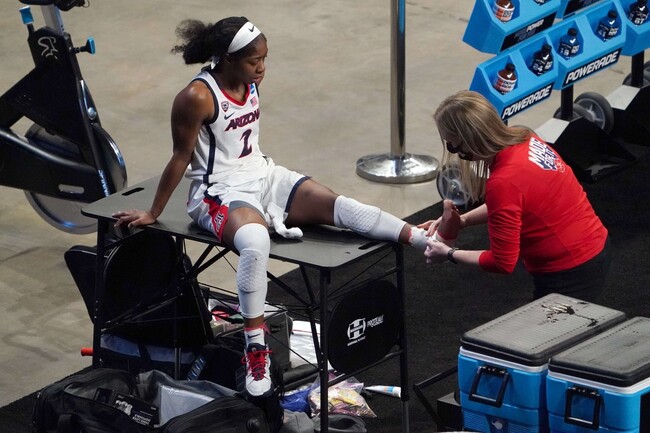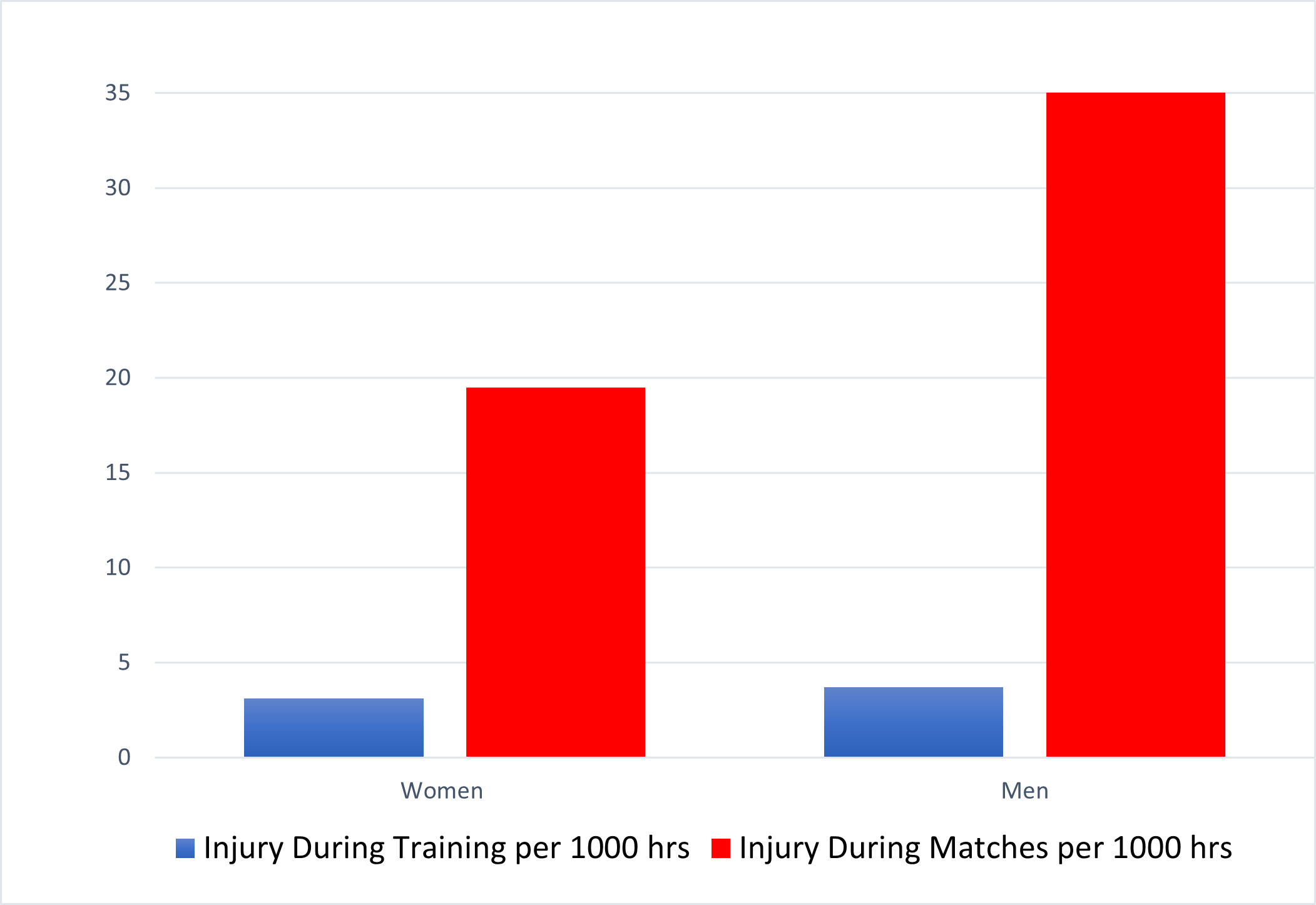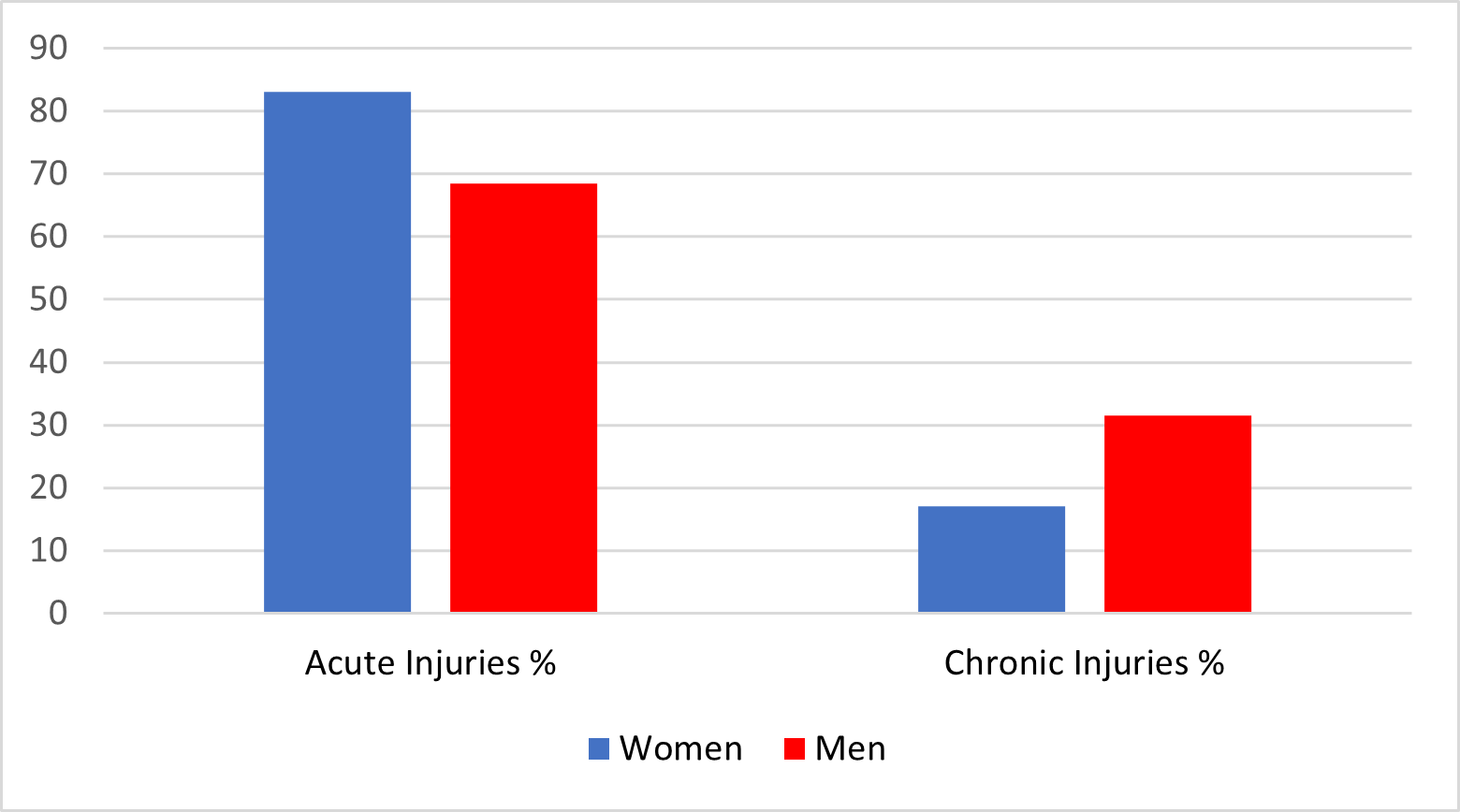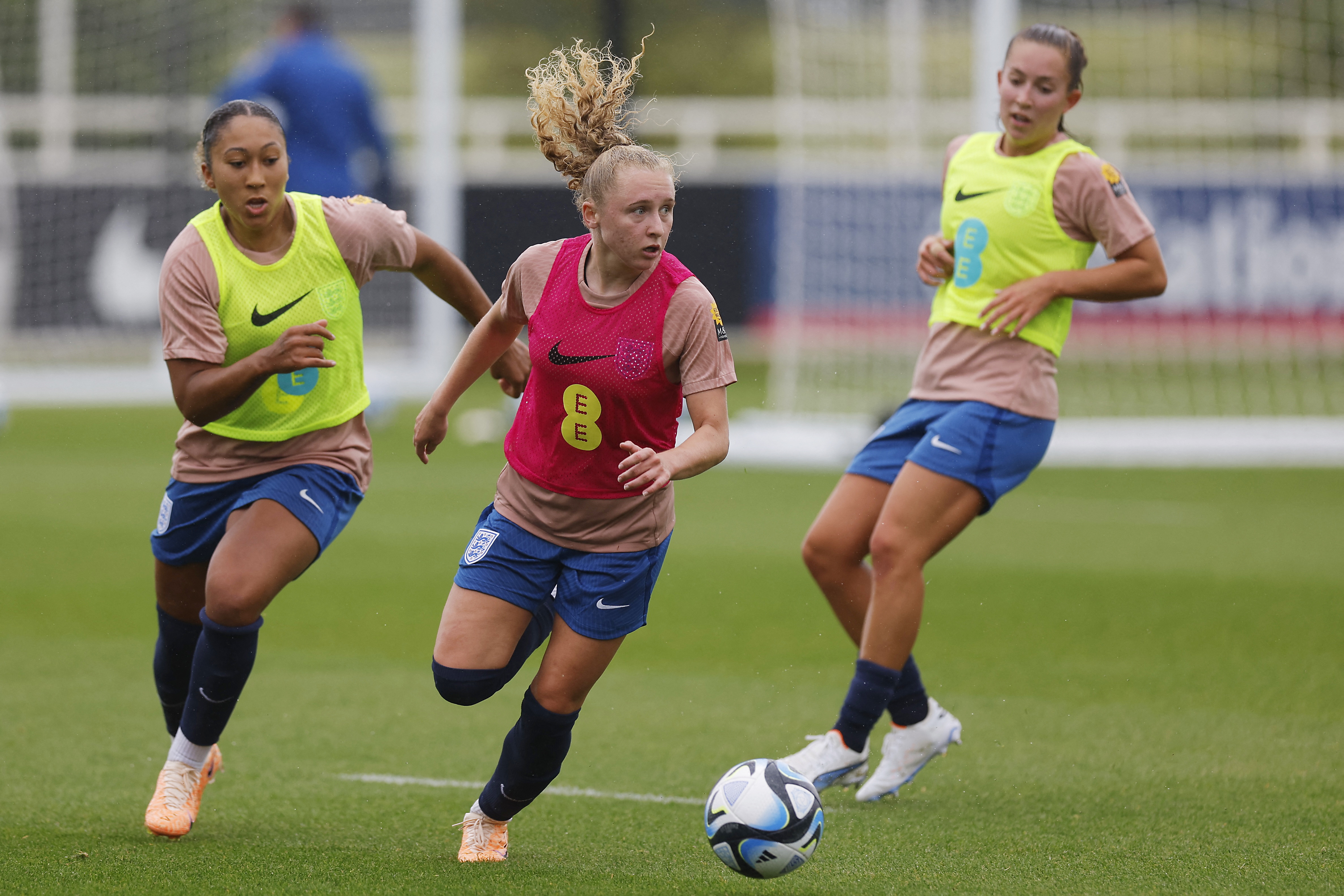The mechanisms of injury across both genders appear to be similar(4). A group of researchers from the United Kingdom aimed to describe the mechanisms of injury associated with common football injuries in males and females. They conducted a systematic review and identified that running and kicking were the principal activities leading to thigh and hamstring injuries. Then, changing direction and kicking led to hip and groin injuries. Duels cause ankle injuries. Finally, duels and pressing appear to be the predominant activities that lead to ACL injuries(4).
Table 1: Most common lower limb injury sites in men’s and women’s football(1,2)
| |
Men |
Women |
| 1 |
Thigh |
Knee |
| 2 |
Knee |
Thigh |
| 3 |
Ankle |
Ankle |
For female athletes, the standouts are ACL and concussion injuries. The incidence of ACL injury in women is (at least) 2,8 times that of men, and they make up a whopping 4,6% of all injuries in women’s football. Female football players are also twice as likely to suffer from concussions than their male counterparts(5). These are both devastating injuries and result in many hours away from play.
ACL Injuries
Half of all ACL injuries occur during competition. Non-contact ACL injuries are the most common, especially in female footballers. Inciting activities vary, including tackling, pressing, defending, chasing a loose ball, cutting, and stopping(4). The average return to sports time for men after ACL Reconstruction (ACLR) is 7-8 months. For women, it is ten months. Because the pool of elite female football players is smaller, this extended absence from play negatively affects team selection.
Anterior cruciate ligament injuries are so common in women’s football that selectors could field a team with players who have had injuries in the last 18 months. There is no doubt that ACL injuries have a massive impact. Analyzing possible causes sheds some light on where clinicians could make a difference while waiting for the research to catch up.
Extrinsic Factors
In the past, technical apparel producers designed football boots for men. Footwear companies have begun addressing this and are designing boots for women. This should have a positive impact on injury prevention, as cleat design on football boots has an impact on ACL injuries(6).
Researchers from West Texas A&M University in the USA compared four styles of football cleats and evaluated the incidence of ACL injuries. Edge cleats are long and irregular cleats around the periphery of the sole with smaller pointed cleats inside. This design produced significantly higher torsional resistance and was associated with a higher ACL injury rate than flat, screw-in, and pivot disc cleats combined(6).
Multiple factors influence players’ perception of the surface they train and play on and its impact on their performance. Wearing the appropriate footwear for the surface can greatly increase or decrease injury risk. Practitioners must
understand the mechanical, perceptual, and physiological differences and similarities between artificial and natural turf.
Intrinsic factors
Hormonal considerations
Female athletes are
at increased risk of ACL injury from the late follicular to the luteal phase of the menstrual cycle. This necessitates developing injury prevention methods that consider the cyclical nature of the menstrual cycle
(7). Given the lack of evidence that combined hormone contraceptive (CHC) use is protective against musculoskeletal pathophysiology, injury, or conditions, it is premature and inappropriate to advocate or prescribe CHC for these purposes
(8). Prevention methods should consider the menstrual cycle and structure training and match-play accordingly.
Anatomy
On average, Women have narrower femoral intercondylar notches, which could cause direct impingement of the notch on the ACL in hyperextension. Contact and friction between the medial aspect of the lateral femoral condyle during pivoting and cutting activities are also increased with a narrower notch(9). Furthermore, there appears to be a relationship between notch width and ACL thickness, with smaller notches resulting in thinner ACLs, irrespective of gender(7). Weaker and thinner ACLs may predispose athletes to non-contact injury, but this is yet to be confirmed(9).
“For female athletes, the standouts are ACL and concussion injuries.”
Another intrinsic factor associated with ACL injury in women is Q-angle. Women have wider Q-angles due to increased pelvic width, shorter femur length, and a more laterally positioned tibial tuberosity. However, internal rotation of the hip is likely a greater risk factor than the Q angle.
Intercondylar notch width, Q angle, and a thinner ACL are all intrinsic factors that athletes cannot change and may contribute to the increased incidence of ACL injuries in women footballers compared to men(7).
Strength and biomechanics
Increased testosterone levels at puberty lead to increased strength and speed in boys compared to girls. This difference in strength and speed ranges from 50-70% and continues into adulthood.
Moreover, there are significant gender differences in the hamstrings/quads (H/Q) ratios. Lower H/Q ratios in women mean they do not have the same protection from the hamstrings to counteract the quadriceps pull(10).
In women, 72% of the time, the mechanism of injury for a non-contact ACL injury is landing from a jump in a knee valgus position(11). When excessive valgus loads are combined with deceleration and weight-bearing, the force applied to the ACL increases(12). Women have a greater tendency to collapse into a knee valgus position with decreased hip and knee flexion, while men bend the knees and hips more and maintain better alignment from the hips to the feet. Moreover, deceleration or acceleration with the foot planted and a change in direction results in a powerful, unopposed – because of poor H/Q ratios - quadriceps contraction near full knee extension(12).
Preventing ACL injuries
Well-designed injury prevention programs reduce the risk of ACL injury for athletes, particularly women(13). These programs attempt to alter the dynamic loading of the tibiofemoral joint through neuromuscular and proprioceptive training. They emphasize proper landing and cutting techniques. Often, practitioners train athletes to avoid excessive dynamic knee valgus and focus on the correct landing mechanics. As girls are typically introduced to football later than boys, they may miss the development of foundational movement competency skills and increase their risk later in life.
Tips to help prevent ACL injuries
-
Assess and address extrinsic factors like boots, cleats, and playing surfaces.
-
Work to improve the H/Q ratio.
-
Address dynamic knee valgus.
-
Include correct landing technique in training.
-
Encourage increased knee flexion angle during sudden deceleration and acceleration tasks.
Ensuring success: clinical prevention programs (14)
- Include strength and power exercises, neuromuscular training, plyometrics, and agility exercises.
- Integrating neuromuscular training into warm-ups increases adherence.
- Practitioners should focus on hip-knee-foot alignment
- Consistent athlete participation and buy-in are the keys to success.
- Practitioners can use the drop vertical jump test to identify players at risk.
Practitioners should enhance neuromuscular capacity through holistic and sports-specific programs. Multi-component, exercise-based programs reduce overall and ACL injuries by 27% and 45%, respectively, in women’s football(13). Moreover, neuromuscular training should include balance, plyometrics, strengthening, and proximal control training. For example, single-leg squats, Russian/Nordic hamstring curls, and planks enhance biomechanical and neuromuscular control during the quick, explosive movements that often result in ACL injuries(13).
“Moreover, neuromuscular training should include balance, plyometrics, strengthening, and proximal control training.”
Practically, injury prevention programs can decrease injury risk(14). An effective neuromuscular intervention program takes approximately 4–6 weeks to create meaningful change. Most programs available to sports medicine practitioners have intense startup periods, followed by less frequent or no additional training(14). Therefore, practitioners must ensure the program’s continuation through integration into the warm-up or an ongoing strength and conditioning program. Each athlete is different, and each exercise program needs to be individualized. Practitioners can also include neuromuscular electrical stimulation to enhance training and rehabilitation outcomes.
Conclusion
There are apparent differences in men’s and women’s football injuries. The most significant differences are in the incidence of ACL injuries and concussions. These are both devastating injuries. It is not possible to change some intrinsic contributing factors. Still, neuromuscular training positively impacts biomechanics and prevents ACL injuries in female footballers.
References
1. BMJ Open Sport & Exercise Medicine 2021;7:e001094.
2. Br J Sports Med. 2020 June; 54(12): 711–718.
3. Scand J Med Sci Sports. 2018 Jan;28(1):237-245.
4. Sports Med. 2023 Jan;53(1):151-176.
5. Phys Sportsmed. 2022 Feb;50(1):11-19.
6. Am J Sports Med. 1996 Mar-Apr;24(2):155-9.
7. J Orthop. 2016 Jun; 13(2): A1–A4.
8. Br J Sports Med. Published Online First: 24 May 2023.
9. Arthrosc Sports Med Rehabil. 2021 Jun; 3(3): e823–e828.
10. J Sci Med Sport. 2008 September; 11(5): 452–459.
11. J Sports Sci Med. 2010 Dec; 9(4): 669–675.
12. J Athl Train. 2008 Jul-Aug; 43(4): 396–408.
13. J Orthop. 2016 Jun; 13(2): A1–A4.
14. Br J Sports Med. 2008 Jun;42(6):394-412
